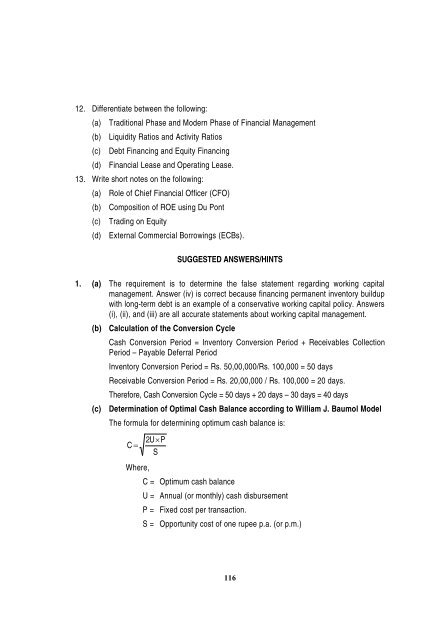PART II : FINANCIAL MANAGEMENT 1. Answer the following ...
PART II : FINANCIAL MANAGEMENT 1. Answer the following ...
PART II : FINANCIAL MANAGEMENT 1. Answer the following ...
You also want an ePaper? Increase the reach of your titles
YUMPU automatically turns print PDFs into web optimized ePapers that Google loves.
12. Differentiate between <strong>the</strong> <strong>following</strong>:<br />
(a) Traditional Phase and Modern Phase of Financial Management<br />
(b) Liquidity Ratios and Activity Ratios<br />
(c) Debt Financing and Equity Financing<br />
(d) Financial Lease and Operating Lease.<br />
13. Write short notes on <strong>the</strong> <strong>following</strong>:<br />
(a) Role of Chief Financial Officer (CFO)<br />
(b) Composition of ROE using Du Pont<br />
(c) Trading on Equity<br />
(d) External Commercial Borrowings (ECBs).<br />
SUGGESTED ANSWERS/HINTS<br />
<strong>1.</strong> (a) The requirement is to determine <strong>the</strong> false statement regarding working capital<br />
management. <strong>Answer</strong> (iv) is correct because financing permanent inventory buildup<br />
with long-term debt is an example of a conservative working capital policy. <strong>Answer</strong>s<br />
(i), (ii), and (iii) are all accurate statements about working capital management.<br />
(b) Calculation of <strong>the</strong> Conversion Cycle<br />
Cash Conversion Period = Inventory Conversion Period + Receivables Collection<br />
Period – Payable Deferral Period<br />
Inventory Conversion Period = Rs. 50,00,000/Rs. 100,000 = 50 days<br />
Receivable Conversion Period = Rs. 20,00,000 / Rs. 100,000 = 20 days.<br />
Therefore, Cash Conversion Cycle = 50 days + 20 days – 30 days = 40 days<br />
(c) Determination of Optimal Cash Balance according to William J. Baumol Model<br />
The formula for determining optimum cash balance is:<br />
2U�P<br />
C �<br />
S<br />
Where,<br />
C = Optimum cash balance<br />
U = Annual (or monthly) cash disbursement<br />
P = Fixed cost per transaction.<br />
S = Opportunity cost of one rupee p.a. (or p.m.)<br />
116

















